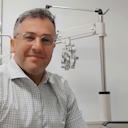Did you know, not all freckles are caused by sun exposure and they aren’t only found on your skin? It’s not unusual for us to have freckles in our eyes too.
We sat down with nib Eye Care Optometrist Arash Zibaee to find out more about naturally occurring and usually (but not always) harmless eye freckles.
What are eye freckles?
Eye freckles, known as nevi (or nevus if there’s just one), are lesions of hyperpigmentation, or a cluster of pigment cells. Similar to skin freckles, nevi are generally small and come in irregular shapes.
“The pigment cells, known as melanocytes, give your skin and eyes their colour,” Arash says.
Ranging from brown to yellow and grey, or a combination, nevi tend to vary in colour depending on the concentration of pigment cells.
Look at your eyes closely in the mirror and you may be surprised at the different colours and markings you see.
If you spot a nevus, it’s most likely in the iris (the coloured part of your eye) as it’s so highly pigmented. Iris nevi are more common than you may think – in fact, around 60% of people have one.
Freckles can also be found on the sclera (white of the eye) or an eye exam could reveal one located inside the eyeball, under the retina at the back, known as choroidal nevus
Related: Why do I have floating spots in my eyes?
What causes eye freckles?
Sun exposure is one reason nevi can appear in the iris or sclera, but they can also be congenital (present from birth).
“Yellow spots visible on the white of the eye are small lumps that appear with age and are mainly due to UV radiation from the sun,” Arash says. “These are mostly benign but need to be monitored by your optometrist from time to time.”
A nevus on the white of the eye usually appears in childhood. Plus, while we’re never born with a chloroidal nevus (freckle on the back of the eye), one in 10 of us will develop one in our lifetime.
It isn’t always clear why nevi appear, but we do know that iris freckles are more common in people with blue eyes, and they’re easier to spot in light eyes than dark ones.
Are eye freckles dangerous?
Only a small portion of nevi become malignant but it’s important to monitor pigmented lesions and look for changes in size, shape, depth and the colour of eye freckles. Typically, darker coloured lesions are more suspicious.
“It’s important for people of all ages and backgrounds to have regular eye examinations and to use modern technology in retinal imagery to locate and monitor lesions for subtle changes over time,” Arash says.
Related: What is UV damage and how does it affect your eyes?
Do eye freckles need treatment?
Most nevi are harmless so no treatment is required, but there’s a small chance they can develop into eye melanoma.
“Those that do require treatment are treated via laser or radiation,” Arash says. “These methods work by destroying the cells that make up the lesion.”
The earlier you have any changes to an eye freckle checked, the sooner any complications can be diagnosed and treated.
Ready to book in an eye test?
It’s important to have your eyes tested by an optometrist at least every two years and more regularly if you notice any eye problems. There are nib Eye Care Centres located across Sydney, Parramatta, Newcastle, Brisbane, Canberra and Melbourne – you can book an appointment at the nib Eye Care website.
Alternatively, if you do not live near a nib Eye Care Centre you could visit nib First Choice Optical network to help you to search for local optometrists; it's our community of specially selected health providers, who have promised they will deliver quality care and value for money.
At nib, we offer a range of Extras covers that include optical benefits. If you’re already an nib member, you can check your current policy using member account. Alternatively, you can get a quote online in just minutes.
Please note: The tips throughout this article serve as broad information and should not replace any advice you have been given by your medical practitioner.

